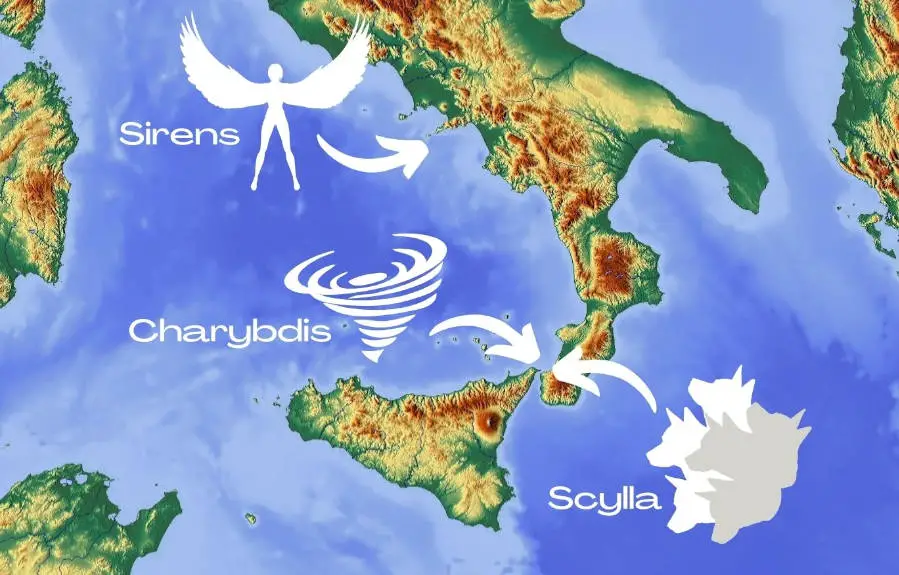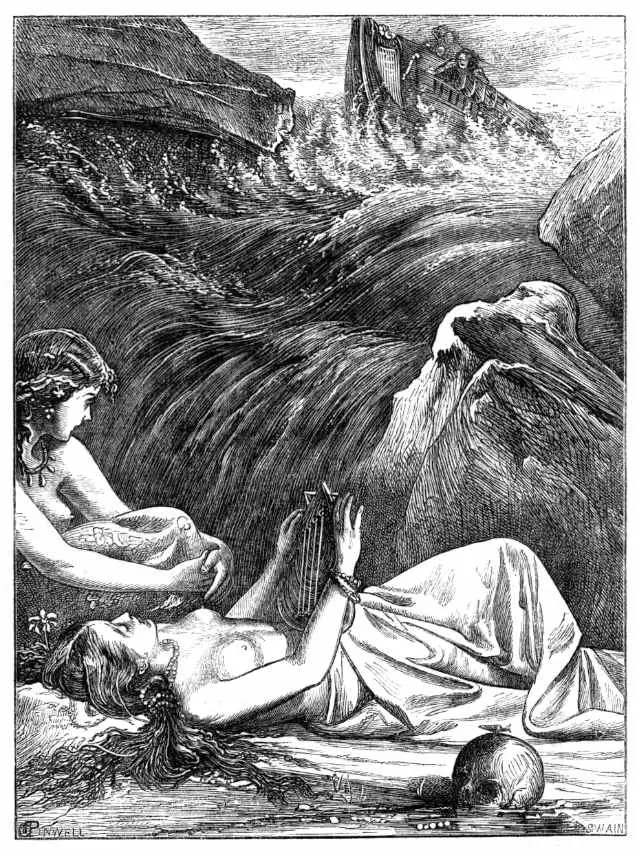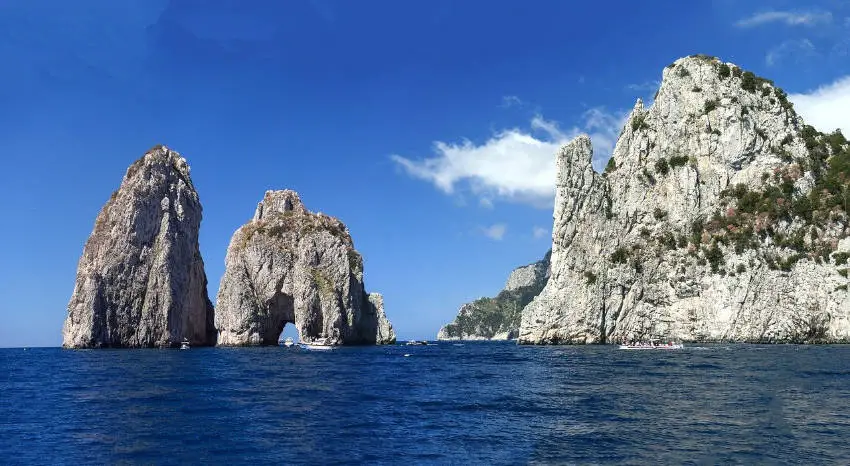Sirens are commonly known as the dangerous mermaids that insidiously lure in sailors with their beautiful voices, only to kill them. These myths go back over 2500 years to ancient Greece and beyond. Could there be some truth behind their story – were sirens real?
Sirens themselves are not real because they are mythological creatures. But their myth is tied to real drownings of sailors. They represented the danger of the rocky shore of Capri in Italy, where ships often sunk and sailors died.
What it means that they are representing rocks and who they really were, I will discuss in the following.
Could sirens even be real?
Even though today most people image sirens as dangerous, but beautiful women with fishtails, that story is not quite right.
Sirens were originally bird-women that had a strong connection to the underworld.
[You can read more about the difference between sirens and mermaids here.]
The idea of the bird women was tied to ancient soul birds who could fly from the world of the living to the underworld and vice versa. Like that they were able to accompany the souls of dead humans down to the underworld (maybe through the sea).
So, given that they were thought to be supernatural beings like that, it seems pretty much impossible for us to tell if they were real or not.
There are however two reasons that tell us that sirens most likely are not real – at least not in our time.
Firstly, it is impossible that a creature is both a bird and a human.
Evolutionarily speaking, birds are actually more closely related to dinosaurs than to humans. Two such different animals could just not exist in the same body.
The same goes for mermaids who are half woman and half fish by the way. I wrote an article about whether mermaids are real here.
The second reason, that sirens are most likely not real, is the fact that they are tied to specific islands and the shipwrecks that might have happened exactly there.
The sirens might have been humanized representations of the rocky shores and might have been used in order to rationalize how all the sailors died on that spot (luring them in too close so that they shipwrecked on the rocks).
In the following I will explain this rock situation in a bit more detail.
The real roots of the myths of the sirens and other sea monsters
In mythology, humanizations are common means that are used to explain unknown forces and natural phenomena.
The most famous ancient piece of literature that the sirens appear in, is the Odyssey by Homer.
In this famous epic poem, the hero Odysseus tries to travel back home to the Greek city Ithaca after he fought in the Trojan war. On his way, he encounters three sea monsters: the sirens and Charybdis and Scylla.

Charybdis and Scylla were real marine hazards
Charybdis is said to be a monster with a giant mouth that swallowed huge amounts of water and even ships. Scylla on the other hand was a mixture of many creatures, but most noticeably were the six snappish dog heads that extended from her waist.
Both Charybdis and Scylla are said to live in the narrowest part of the Strait of Messina, which is the part of the sea between the island Sicily and Calabria at the southern tip of mainland Italy (see the picture above).
And here is where it gets interesting. Charybdis and Scylla are believed to actually be real, dangerous locations in the sea that likely have caused sailors to shipwreck in the past.
Charybdis is connected to a real whirlpool on the Sicilian side and Scylla represented a rock shoal (shallow waters) on the Calabrian side of the strait.
And both whirlpools and rock shoals could pose a serious threat to sailors back in the day!
The whirlpool is called Garofalo today. It is however rather small and technically a maelstrom that and forms and turns dangerous in stormy weather. So, in the ancient world, it might have only posed a serious threat to sailors in small boats or during storms. Or it was bigger back then.
The rock shoal could have easily made ships crash in the shallow water, making the men fall off the ship as if they were pulled off by Scylla’s hungry dog heads. There is also a rock called “The Rock of Scilla” that is thought to have been the home of Scylla.
This shows that Homer’s story of the two sea creatures was just a way of describing these two sea hazards that Greek sailors were facing when they sailed through the unknown waters of the Mediterranean Sea.
The dangerous islands of the sirens are a real place
Now, the sirens appear in the same book of the Odyssey, shortly before Odysseus sails past Charybdis and Scylla.
[Related: All about the Sirens in the Odyssey]
According to the story of the Odyssey, the sirens lived on an island that was surrounded by cliffs and rocks on which the sailors shipwrecked.
The following illustration depicts these dangerous rocky shores well.

Such rocky seashores are actually one of the most dangerous places for ships to pass because they can easily get caught in the wild currents and smash against the rocks which can make them sink.
This begs the question if the sirens were also imaginative descriptions of the dangerous rocks that Odysseus had to sail past.
According to Homer the island of the sirens was located in the western sea between Aeaea and the rocks of Scylla. Aeaea was thought to be the modern-day island called Elba on the north-western shore of Italy.
So the islands of the sirens would be somewhere in the Tyrrhenian Sea off the coast of south-western Italy because Odysseus sailed down that way in the direction of Charybdis and Scylla (see map above).
According to Roman poets, the island where the sirens lived was actually one of a few small rocky islands called Sirenum scopuli that were located around that area.

In another version of the myth, the island was called Anthemoessa (or Anthemusa) and thought to be the current island of Ischia or Capri which are close to the city Naples. The Sirenuse islands, next to Capri, are even named after the sirens and could also be the ones.
As you can see, the place where the sirens lived might really exist. But just like with Charybdis and Scylla that might mean that the sirens themselves were not real, but just imaginary expressions of the dangers of crashing into these islands.
The rocky shore of Capri actually gives us some hints on why the sailors really sailed so dangerously close to the shore: Not because the sirens called them but because the ancient Greeks and Romans sailed by sight along the coasts of Italy.
This helped them not get lost at sea, particularly at night, and also protected them from pirates that would not come too close to the shore.
Sailing so close to the shore was extremely dangerous because the chances of crashing into rocks or running aground were very high!
That is why the rock formation on the shore of Capri might be called Faraglioni, referring to the Greek word “pharos” which means lighthouse:
Because of all these shipwrecks so close to that rocky shore, people in the ancient world started lighting signal fires up there. They served as simple lighthouses that reduced the number of shipwrecks around Capri by helping the sailors make their navigation safer at night.

This could also shed a whole new light on the sirens.
One interpretation would be that the sirens were just sitting there on their islands and waiting for the sailors to die by themselves instead of actively luring them in in order to make them die.
After all, they were known to be the guardians of the dead and would have to guide all those souls of the sailors who foolishly sailed too close to the shore anyway.
So why not sit down right at the busy spot, make some music and wait for the next travelers to the underworld to come to them!
In fact, in the Odyssey, the sirens are just described sitting in their meadow on the island and singing to Odysseus about secret things they can tell him (if he dies and gets accompanied into the underworld that is).
According to this interpretation the sirens were not the real danger here.
They just represented the situation between life and death that Odysseus and his crew got themselves into by sailing so close to this dangerously rocky shore.
So, since the sirens do not seem to be marine hazard themselves, like Charybdis and Scylla, they cannot be real in that way.
Logically speaking, they are soul bird women who accompanied dying sailors to the otherworld, meaning they are mythological beings that were often associated with the real rocky shore around Capri, Italy.
If the sirens were real, they might have died a long time ago
If the sirens were real, they might have run into trouble after Odysseus passed them though.
According to some post-Homeric authors, they were fated to die if someone heard their voice and survived. Thus, they were said to have jumped into the water and perished after the encounter with Odysseus.


